Blue Triad EX (2011)
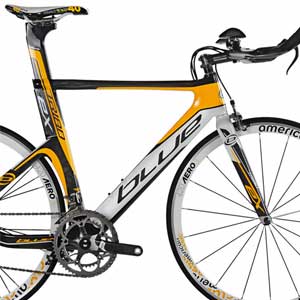
Blue makes three models of tri bike: The Triad SL, the Triad EX, and the Triad SP. The SP and the EX are identical frames, just with different spec and paint. The SL looks an awful lot like the EX/SP, just with a different fork, much like the Felt bikes (excepting the all-new 2011 DA) pop out of the same mold, and some have standard forks and some have Bayonet forks.
But, the new 2011 SL is a new frameset, out of a new mold, not simply a frame of the same shape with a different carbon schedule.
Last year's Triad SL was in-between the 2011 EX and the 2011 SL. Last year's SL popped out of the EX mold, but with the SL's carbon schedule. I know this is a bit confusing, but, if you're with me so far, well, so far so good.
In the 2009, Andreas Raelert rode Blue's Triad SL, and that frame, with a different carbon lay-up, is the bike we're reviewing here.
But, even that's not precisely right. Andreas is a Shimano athlete, and while the Triad EX comes with four available groupkits (SRAM Red @ $6700 complete; Shimano Dura Ace @ $6800 complete; Ultegra @ $4500 complete), we're going to look at the EX with SRAM Force, which will sell as a complete bike for around $4600.
The Raelert brothers remind me of the fighting Klitschkos: What you really want to see is the two of them, at their best, dueling for a long course world championship title. But Andreas, the older of the two, and a 2-time Olympian, is the Ironman. The younger Michael is the 2-time 70.3 World Champ. They seem to stay out of each others' wheelhouses.
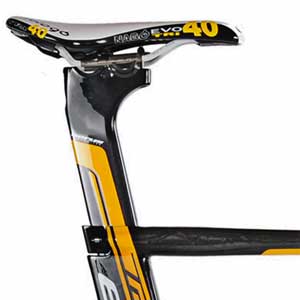
Andreas rides a Blue, Michael a Trek. I'd like to talk about Andreas a little because, what I've observed from the outside looking in might be instructive when considering how this bicycle reviewed here might work best for you.
Geometry
Let's start at the beginning, which for me is (of course) geometry. Blue bikes are not long. The longest reach in a Blue Triad is 43cm, and that's in its largest size (LG). Let's compare this to a Cannondale Slice in a 60cm size. This largest Slice size has a reach of 42.5cm. Pretty close. The Blue Triad in this LG size has a stack of 57.7cm versus the C'dale's 57.2cm. In other words, the Blue Triad is almost identical to the Slice—if the Slice was made one a size very slightly larger than its 60cm size, that's the geometry of the Blue Triad size-LG.
Likewise, the Triad in ML (the next size down) is slightly taller than the Slice in 58cm (55.8cm versus 54.8cm in stack) but it's slightly narrower (41.4cm versus 41.7cm in reach).
So, the Triad, the Slices, the Scott Plasmas, are all quite geometrically similar, and they favor—all things equal—those who ride not quite so steep, and/or those with long legs and short torsos, and/or those who don't ride very low in front.
This theme is expressed throughout the Triads' 5 sizes, from XS to LG. All are made with 700c wheels, so—you know me by now—I think this disqualifies the bike from consideration if you're 5'5" or shorter (what you ought to be riding is a nice 650c-wheel bike, such as those ridden by both the current women's Hawaiian Ironman and current women's World Time Trial champion).
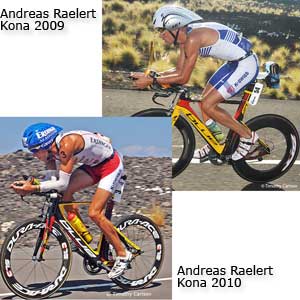
Andreas Raelert
Does the list of probable customers above—long-legged, or less than ultra-steep—include Herr Raelert? Well, yes and no. Alongside are two pics of the speedy German, the top pic of Andreas at the Hawaiian Ironman in 2009, the bottom in 2010. You can only glean so much from a single set of pics, but, based on these pics, I prefer his position this year over last year. He seems to have preferred it as well, using only his bike split time as a guide. He rode 6 minutes faster during years when the bike splits seem not too different year over year (Macca was within the same minute each year, Crowie was 2 minutes faster in 2009, Lieto was 2 minuttes faster in 2010).
I mention this for the following reason: Apart from training, experience, and tactics, the obvious mechanical difference in Raelert from one Kona to the next was somewhat the bike, but more so the bike's aerobars. In 2009, Raelert rode the aerobars featured on the bike reviewed here today (they are pictured below). In 2010 Raelert rode a set of aerobars that were much lower profile, and these bars seem to have in large determined the (lower) position he seemed to ride on 2010 versus 2009. The two sets of aerobars, both made by Blue, are pictured below, and you can see the obvious difference in elevation.
Andreas Raelert is 6'1". He rides with 79cm of saddle height (BB to the top of his Fizik Arione Tri 2, measured midway fore/aft). He's almost exactly my height, and, because he rides with my saddle height, he's probably almost exactly a morphological match to me (our chassis may be similar, but, our engines differ dramatically!).
Andreas rides with the nose of his saddle about 2.5cm behind the BB, and he rides with an armrest drop of 14cm. For comparison's sake, I ride with my saddle nose about even with the BB, and I ride with 15cm of armrest drop. But, I don't quite nose ride my Profile Design TriStryke, so, I probably sit more forward than Andreas, but not quite 2.5cm forward of him.
Accordingly, his armrest drop is more or less what I might expect, if I'm "normalizing" his position relative to my own: He rides probably 1.5cm to 2cm to the rear of where I ride on the saddle, and his armrests are correspondingly 1cm higher.
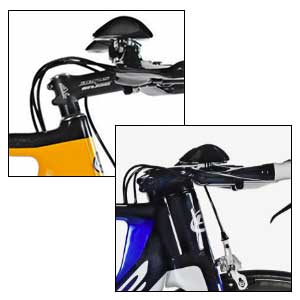
My take away is this: the Triad is a better bike for Andreas than for me, because that 2cm of aft sitting means a 41.5cm or 42cm reach is probably fine for him. I prefer a bike with more like 44cm of reach, and that's because—even though I'm almost the exact morphological match of Andreas—I ride slightly steeper. Ergo, Andreas fits one of the "prerequisites" for an ideal Triad customer: he rides mid-steep rather than very steep.
Front end
Still, he gets that 14cm of drop via his Aerus Tri Carbon aerobar. Is he riding with more drop than last year, as the pic seems to suggest? I don't know. But what I do know is that the bar he was riding last year—the Aerus TTB Carbon spec'd on the bike reviewed here—seems considerably higher profile than the Aerus Tri Carbon. You can see the difference in elevation adjacent. The bars that come on the 2011 Triad EX—the bars Raelert rode last year—have the higher profile armrests.
This matters because you must decide what style of rider you are, and you must match the bar to the frame to get the geometric profile you need. For example, when I built up a Cannondale Slice for myself this past year, I couldn't ride the high-pad Profile Design T2, rather I resorted to Felt's low-profile Devox bar. It would not surprise me to find that Andreas found his lower position through the use of a change in his aerobar. He looks to my eye more comfortable, powerful, and aerodynamic now than he did in 2009.
Fortunately, the Triad EX is spec'd with a standard fork (1" steerer), on which you can use any aftermarket stem and aerobar you want. The Aerus TTB Carbon might be your perfect solution, but, if not, a flat (horizontal) stem with a low profile aerobar seems to have been the way Andreas Raelert got the most out of his Blue. It might be the way you may get the most out of yours.

Aerus
Aerus is to Blue what Bontrager is to Trek, and Devox is to Felt. It's Blue's house brand components and accessories company. I haven't tried the bars, though they look quite nice. The Aerus TTX—the bars coming on the Triad EX—are the only Aerus aerobars sold by Aerus in the aftermarket.
The stem is pitched, and I think that's a spec mistake. This is a tall frame for its length. Most riders are going to have no problem getting high enough, especially with the architecture of the aerobar spec'd on the bike. Most folks are going to have the opposite problem. So, this bike needs to be spec'd with a flat stem.
That's no real problem, of course, you just slide the stem off and put a flat stem on. Except the stem is an Aerus stem—branded and logo'd as such—and unless and until Aerus means what 3T or Cinelli means to the marketplace, most folks don't want Aerus stems on Felt bikes anymore than they want Felt stems on Trek bikes or Cervelo stems on Cannondale bikes. This is creates a problem for retailers, who must absorb hard to sell OE stems (which get thrown into the same box with house-branded, worthless, OE saddles).
On the plus side, the EX is spec'd with a low-profile, 5mm tall, Cane Creek headset top cap, that lowers the front end of the bike.
Frame
The Blue Triad has a chain stay shape that reminds one of Scott's Plasma frames. The shape of the stays—the cable routing, the clever fairing of the rear derailleur—was "a large part of why [the Plasma] went so well in the tunnel," according to Scott. The Triad's chain stay may well achieve the same benefits.
The seat stays are distinctive on Blue's timed race bikes. They meet the seat tube partway up—well below the seat cluster—giving this bike what seems might be an aero advantage, by cleaning up the trailing end of the frameset. This would be a lost cause if there were a rear brake caliper and cabling to consider, but the rear brake is situated under the chain stay. That rear brake caliper is a Tektro 725—an unfortunately side-pull design, the cabling of which tends to interfere with the left-side crank arm unless mounted with precision.
Gruppo
But the front brake caliper is a SRAM Force, and that's good. Let's talk about this groupset.
When we polled Slowtwitchers on gruppos for their 2011 bikes, they overwhelmingly chose Ultegra as their groupset of choice. More than a third of you selected Shimano's fine groupset. The next most popular kits were Dura Ace and SRAM Red (almost tied) and Force lagged behind all these. The curiosity here is that Force is more or less analogous to Ultegra, and in some ways it's an improvement on it.
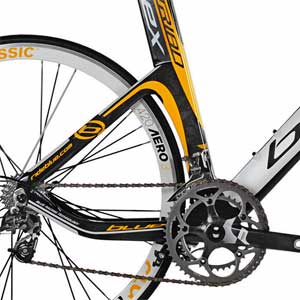
Specifically, while the jury is out on SRAM's R2C shifters, the SRAM TT900 shifter is undeniably a big upgrade over Shimano's ancient bar-end design. This makes the SRAM system a better shifting system than anything Shimano offers, not counting Di2, where Shimano has developed a new and superb timed race shift system. Blue fortuitously forewent the R2C in favor of the TT900 on the Triad EX, making this best drivetrain-spec'd tri bike model I've seen for the 2011 season.
The crankset, front and rear derailleur, and cassette are all Force, the cassette is a very useful 11-26 10sp, the chainrings might be a slight overkill at 54/42. West Coasters might need to move to something smaller than 42×26 as the lowest gear on the bike. The chain is Wipperman's 10S8. Bravo. Buy a chain from a chain company, I always say.
And here's another attaboy for the wheel spec. How nice for an American bike company to spec a storied American wheel brand? Blue Triad EX owners ride aboard a set of American Classic 420—a smart looking, all-purpose wheelset with 18 radial bladed spokes in the front, and 24 blades in the rear, laced 3-in-a-cluster.
Blue strikes again with an intriguing spec choice for saddle. Spartacus rides this Prologo, and I've got one sitting in my workshop ready to mount and try. I'm excited to sit aboard this thing and see how my boys like it. My boys are partic'lar, and who knows how they'll react? Not me, they have minds of their own. Nevertheless, this is a neat saddle and a swashbuckling choice.
Overall
You might think that the Triad EX, spec'd as it is, is $800 or so overpriced versus those in its competitive set. But this is until you consider the fact that this bike is not downspec'd at all. The wheels, consumables, and saddle are first rate and—while I've never ridden them—the aerobars are obviously an expensive and impressive effort. Therefore, it is priced correctly considering what you get.
My only concern about this bike is its height, as it is set up and spec'd. This height problem is what caused Cannondale to switch from spec'ing Profile Design T2 aerobars in 2010 to Visiontech bars in 2011 (The Visions weren't necessarily better than the Profile Design bars, rather the low height of the Vision aerobars were a better thematic match for the tall height of the Slice frame). A rider choosing a Triad EX may find he has to take pains to get the armrests lower.
But those pains need not be painful. Let us say I sold both Felt and Blue in my retail store. For the rider who needs a lower front-end, just pull off the Aerus TTB Carbon bar and replace it with a Felt Devox. I promise you, a Felt customer is going to come along who needs a higher front end on his bike, and the Aerus TTB will fit the bill nicely.



Start the discussion at slowtwitch.northend.network